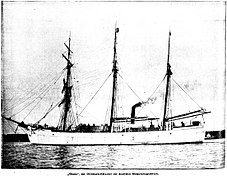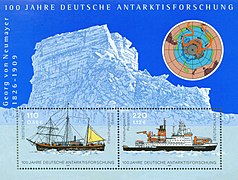Gauss (ship, 1901)
|
||||||||||||||
|
||||||||||||||
|
||||||||||||||
|
||||||||||||||
|
||||||||||||||
The first Gauss was a barquentine that was used to explore the Antarctic and was used from 1901 to 1903 during the German Gauss expedition under Erich von Drygalski .
story
In 1899 the German Reichstag approved 1.2 million marks for the construction of a resilient research ship , which was built according to the drafts of the naval construction councilor Otto Kretschmer under the supervision of the Reichsmarinamt at the Howaldtswerke shipyard in Kiel . The plans were based on the Fram of polar explorer Fridtjof Nansen . The ship was on April 2, 1901 launched in and by the geographer Ferdinand von Richthofen in honor of Carl Friedrich Gauss baptized , the first the importance of the South Pole for the earth's magnetic recognized research and the position of the magnetic south pole was determined by calculations. The South Pole Expedition was a project of the German Reich and was organized by the Ministry of the Interior .
The Gauss was rigged more beautifully as a three-masted topsail . It also had a screw drive with a three - crank triple expansion steam engine , electrical lighting and steam heating . The ship was 46 m long and 11 m wide. With a draft of 4.8 m, the water displacement was 1,450 tons. A speed of seven knots could be achieved both under engine and only under sail.
Various measures were taken to protect the ship from damage caused by the ice drift. Man
- used a triple, firmly connected planking made of oak , American spruce and greenheart ( see also green heart wood ),
- attached specially constructed steel plates to the bow and stern,
- laid inner supports made of grown oak crooked wood,
- offset the lower deck near the water line,
- designed a relatively round hull cross-section in order to lift the ship onto the ice when the ice is under pressure and thus prevent it from being crushed.
The latest polar research findings have been taken into account when furnishing and equipping the ship . The equipment included two steam winches for scientific research and for the anchor devices , an apparatus for the distillation of drinking water, a fire extinguisher, a naphtha motor boat and five other boats, a number of sleds that were to be pulled by 77 Siberian dogs, two tethered balloons with the required hydrogen gas in 455 seamless steel cylinders, a searchlight, the most modern fishing gear and reliable physical instruments. Oil tanks were installed on both sides of the navigating bridge in order to drain off wave calming oil if necessary .
The Gauss contained accommodations for five researchers, five officers and a crew of 22 men. The nautical leader of the ship was Captain Hans Ruser , who was subordinate to the scientific expedition leader, Erich von Drygalski .
The Gauß left Kiel on August 11, 1901 and returned there on November 24, 1903.
In 1904 the ship was bought by the Canadian government, renamed Arctic and made available to the captain Joseph-Elzéar Bernier for a North Pole voyage . As Arctic , she sailed seven years under the command of Bernier through the northern Canadian islands and wintered 1906-1907 off Baffin Island, 1908-1909 off Melville Island and 1910-1911 in Admiralty Inlet. Due to the five-year presence in these waters, Bernier officially took possession of the Arctic Islands for Canada on July 1, 1909. The Arctic was then used, among other things, as a supply ship for settlements in the far north of Canada until the twenties and was reactivated for four years for exploration tasks from 1922, again under the then 70-year-old Captain Bernier. After these repeated trips, the ship was badly damaged and was sold for demolition. The strong wooden construction withstood the scrappers' efforts and so the ship was slowly left to rot.
The Gauss is the namesake for Gauss Beach , a beach on the island of Heard in the southern Indian Ocean.
Photograph from the daily newspaper “ Der Tag ” from July 16, 1901
The Gauss trapped in the ice on March 29, 1902.
This photo taken from a tethered balloon is one of the first aerial photographs in Antarctica."100 Years of German Antarctic Research" stamp pad from Deutsche Post AG from 2001. Gauß on the left, Polarstern on the right
Individual evidence
- ↑ Launch of the German south polar ship. In: Ostdeutsche Rundschau. Viennese weekly for politics, economics, art and literature / Ostdeutsche Rundschau. Deutsches Tagblatt , April 3, 1901, p. 7 (online at ANNO ).
- ↑ Rudolf Curtius: The South Pole, the last secret of the globe. In: Ostdeutsche Rundschau. Viennese weekly for politics, economics, art and literature / Ostdeutsche Rundschau. Deutsches Tagblatt , August 11, 1901, p. 15 (online at ANNO ).
- ↑ Returned South Polar Expeditions. In: Neuigkeits-Welt-Blatt , November 27, 1903, p. 6 (online at ANNO ).




